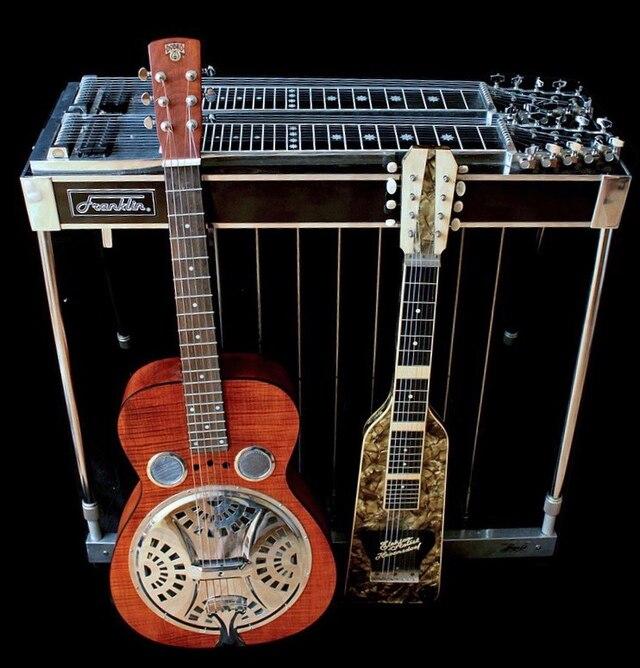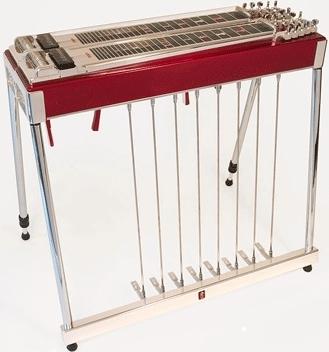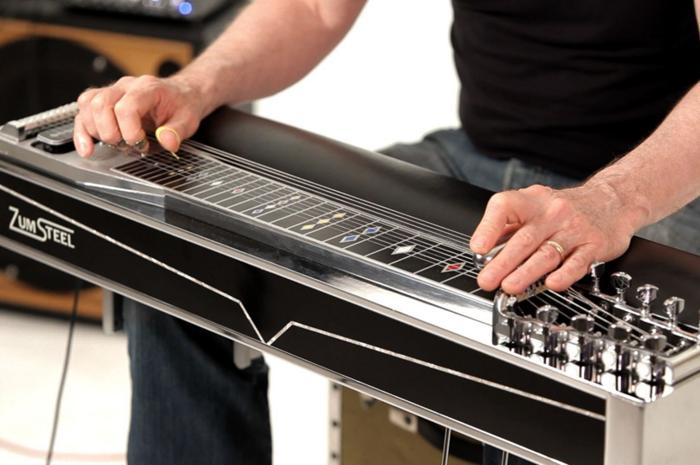In the early days of my journey into lutherie, I stumbled upon a local band where the haunting melodies of a steel guitar transformed the ordinary into the extraordinary. But was it a lap steel or a pedal steel? That question sent me down a path of discovery, learning to differentiate between these two captivating instruments and their distinct roles in music. What are the key differences, and how do they impact your choice of guitar? Join me as we delve into the intricacies of lap steel and pedal steel guitars, focusing on design and mechanics, unique playing techniques, and the secrets to unlocking their potential in your musical journey. Whether you’re drawn to the lap steel’s simple charm or the pedal steel’s rich complexity, understanding these differences will guide you to the right choice and elevate your playing experience.
What are Lap Steel and Pedal Steel Guitars?

Did you know that the lap steel guitar’s origins date back to Hawaiian music’s rise, while the pedal steel expanded the musical landscape in country and beyond? As an engineer and luthier, I’ve traced the fascinating evolution of these instruments, understanding how each has carved its niche in American music traditions.
The lap steel guitar emerged in the late 19th century, initially gaining recognition through its distinctive sound in Hawaiian music. Its vibrant tones and simple design captivated audiences, setting the stage for its influence in other genres, such as blues and country. Players typically rest the guitar on their laps, using a solid steel bar to slide across the strings instead of conventional fretting. This technique produces gliding, emotive tones that are instantly recognizable and evoke a sense of nostalgia and connection to its Hawaiian roots.
The pedal steel guitar, on the other hand, marks a significant shift in complexity and capability. Evolving mid-20th century from its lap steel predecessor, it incorporates foot pedals and knee levers. These innovations allow for seamless pitch changes and a broader harmonic range, opening expansive musical possibilities and diversifying its appeal beyond country music.
Through my work understanding and crafting these instruments, I’ve seen firsthand how their unique designs and historical contexts have shaped their sounds and application in modern music. These guitars remain vital, offering musicians intricate ways to express emotion and musicality.
What are the Key Differences?
Design and Mechanics

As we explore the key differences between lap steel and pedal steel guitars, it’s essential to delve into their design and mechanics. Consider this: How do the unique mechanical features of pedal steel guitars enable them to produce complex harmonic textures?
From an engineering perspective, pedal steel guitars fascinate me with their intricate system of pedals and knee levers. These mechanisms allow musicians to alter string pitch in real-time, contrasting the more straightforward structure and tuning mechanisms of lap steel guitars. With my engineering background, I particularly appreciate these precision components that make pedal steels a marvel of modern instrument design.
This complexity grants pedal steels the ability to produce a broad array of harmonic textures and tonal variations, setting them apart from their lap steel counterparts. Understanding the mechanics of pedal steel can profoundly influence your choice of instrument, offering a richer and more dynamic musical experience.
Playing Techniques

What if the way you learn to play could dramatically alter your musical expression? This question has resonated with me ever since I picked up my first lap steel guitar. Drawing from years of exploration in various playing styles, I have come to appreciate how the lap steel and pedal steel guitars demand and cultivate distinct techniques that imbue each with a unique sonic character.
Lap steel playing techniques focus heavily on bar control and right-hand picking strategies. The player, often seated, emphasizes smooth glides and bends that evoke a vocal-like quality. This approach fosters a raw, roots-oriented musical conversation, highlighted by the absence of pedals that allows unencumbered expression.
In contrast, pedal steel playing techniques introduce a complex matrix of foot pedals and knee levers. This complexity enables intricate chord changes and vibrant pitch shifts, elevating the instrument’s harmonic possibilities. Mastering this style opened a new realm of tonal exploration for me, pushing the boundaries of traditional musical composition.
Understanding these techniques is crucial when considering what makes each instrument special. As we journey deeper into soundscapes influenced by each style, remember that your choice between lap and pedal steel is not just about the instrument itself but the personal expression and musical journey it promises.
Why Choose Lap Steel or Pedal Steel?
Ease of Learning

Is it true that one guitar can be the gateway to your musical journey while the other poses a formidable challenge? As someone deeply immersed in the world of steel guitars, I often grapple with this question. **Ease of learning** greatly influences a beginner’s choice in the debate between lap steel and pedal steel. With its straightforward mechanics, the **lap steel** serves as a welcoming *introduction* to the captivating world of steel guitars. Many beginners I’ve worked with find the *lap steel* offers a streamlined path to grasping basic techniques, fostering an early sense of accomplishment.
In contrast, the **pedal steel**—with its intricate mechanics and demanding coordination—presents a daunting but profoundly *rewarding* challenge. While it may initially deter some, the depth of expression and versatility it offers are unparalleled for those willing to tackle its learning curve. Understanding this curve, as I always emphasize, is essential to unlocking its full musical potential.
Choosing between these instruments can thus define your entry point into becoming a steel guitarist. Evaluating the ease of learning helps in setting realistic expectations and aligning with one’s musical aspirations, whether you’re drawn to the simplicity of the lap steel or the complex allure of the pedal steel. This consideration leads naturally into exploring the **Sound and Musical Genres** these instruments inhabit, bringing us closer to understanding their unique voice in the music landscape.
Sound and Musical Genres

Could the choice between lap and pedal steel determine the genre you play most authentically? This question underscores the crucial role sound characteristics and musical genres play when selecting these instruments. Through years of experimenting with sound, I’ve discovered that lap steel guitars excel in genres like blues and Hawaiian music due to their distinctive, resonant tone. The lap steel sound is often described as raw and expressive, making it ideal for emotive solos.
Meanwhile, the pedal steel sound is renowned for its complexity and versatility, often associated with the lush, layered soundscapes heard in country and pop music. The ability of pedal steel to produce intricate harmonies and sustain lends itself beautifully to genres requiring depth and texture. My personal journey with these instruments has shown me how each plays a unique role in music creation, bridging diverse musical styles and enhancing authenticity in performance.
Understanding these sound characteristics not only helps in choosing the right instrument but also aligns your musical identity with the music genres for lap steel or music genres for pedal steel, ultimately enriching your musical journey. As we move forward, we’ll delve into other practical aspects that might influence your decision, such as ease of learning and transportability.
Transportability and Usage

Have you considered how the convenience of traveling with an instrument could shape your performance opportunities? From my extensive travels as a musician, I’ve learned firsthand how the transportability of lap steel guitars offers a significant advantage over pedal steels, particularly for beginners. The compact nature of a lap steel guitar means it’s much easier to pack up and move, making it ideal for musicians who frequently perform at different venues or enjoy spontaneous jam sessions.
In contrast, pedal steel guitars, with their intricate mechanics and additional components like foot pedals and knee levers, are more cumbersome to transport. This can be a limiting factor—not only for the spontaneous street performer but also for the studio musician with frequent setups. Lap steel vs pedal steel for beginners really boils down to practicality in part; while a pedal steel’s expressive potential is unmatched, its logistics may deter the uninitiated or those seeking a nimble setup.
Ultimately, my experiences underscore that choosing an instrument is not just about its sound or playability but how it integrates into your lifestyle. Determining the right guitar involves weighing these practical considerations against your musical aspirations.
Conclusion
Can one conclusion truly encapsulate the diverse worlds of lap and pedal steel guitars? As I reflect on the key distinctions highlighted in this article, it’s clear each instrument carries its own unique charm and functionality. Lap steel guitars offer a simplistic design and are easier to transport, making them ideal for beginners and those preferring a straightforward approach. In contrast, pedal steel guitars provide a rich, complex sound, suitable for musicians eager to delve into advanced techniques. As a lifelong learner, I encourage musicians to continually explore both in order to fully appreciate their unique virtues and expand their musical horizons.
FAQs

R.M. Mottola, an engineer-turned-luthier, revolutionizes stringed instrument design with his deep focus on acoustics and ergonomics since 1994. As editor of the Savart Journal and a key contributor to American Lutherie, Mottola merges science with artistry in lutherie. He enriches the field with his extensive knowledge, shared through his Liutaio Mottola website, making him a beacon in the world of modern instrument craftsmanship.
